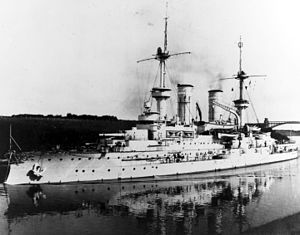| 24 cm SK L/40 | |
|---|---|
 Twin C/92 turret aboard SMS Wettin | |
| Type | Naval gun Coastal artillery |
| Place of origin | German Empire |
| Service history | |
| In service | 1898-1945 |
| Used by | German Empire Austria-Hungary Netherlands Nazi Germany |
| Wars | Boxer Rebellion World War I World War II |
| Production history | |
| Designer | Krupp |
| Designed | 1894 |
| Manufacturer | Krupp |
| Produced | 1898 |
| Variants | Krupp 24 cm L/40 K94 Skoda 24 cm L/40 K97 Skoda 24 cm L/40 K/01 |
| Specifications | |
| Mass | 24,000–25,600 kg (52,900–56,400 lb) |
| Length | 9.5 m (31.2 ft) |
| Barrel length | 8.8 m (28.9 ft) |
| Shell | Separate loading cased charges and projectiles |
| Shell weight | 140–151 kg (309–333 lb) |
| Caliber | 24 cm (9.4 in) caliber |
| Breech | Horizontal sliding-wedge |
| Recoil | Hydro-pneumatic |
| Elevation | Naval Mounts: -5° to +30° Coastal Artillery: -5° to +46° |
| Traverse | -150° to +150° |
| Rate of fire | 3 rpm |
| Muzzle velocity | WWI: 690 m/s (2,300 ft/s) WWII: 810 m/s (2,700 ft/s) |
| Maximum firing range | WWI: 16.9 km (10.5 mi) at +30° WWII: 26.6 km (16.5 mi) at +46°[1] |
The 24 cm Schnelladekanone Länge 40, abbreviated as 24 cm SK L/40, was a German naval gun developed in the years before World War I that armed a number of the Imperial German Navy's pre-dreadnought battleships and armored cruisers. Later; a number of these guns were removed from naval ships and converted to coastal artillery; which would see service during World War I and World War II. The actual bore diameter was 23.8 cm (9.4 in), but the classification system for artillery rounded up to the next highest centimeter.
- ^ DiGiulian, Tony. "Germany 24 cm/40 (9.4") SK L/40 - NavWeaps". www.navweaps.com. Retrieved 2017-03-20.